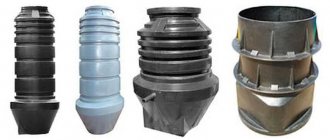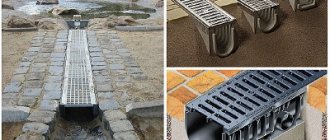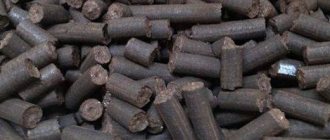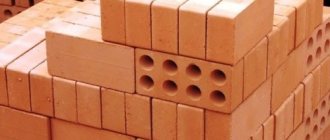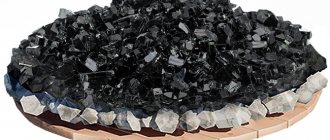Thanks to technology, achieving the task is not difficult.
For example, polymer wells, which have become an alternative to conventional reinforced concrete products.
Let's find out if they are as good as they say.
Classification methods: types and sizes
Plastic rings are used in arranging communications of all types. Therefore, if we take into account the scope of application, we can select products for a well (drinking water), for a septic tank or sewerage system. It is convenient to divide products according to the material from which they are made; in this case the following options are possible:
- Made from polyethylene. The main advantages of plastic are its long service life and indifference to significant temperature fluctuations (from -50 to +70°C), which allows its use in most climate zones. Polyethylene rings have a multilayer structure, which increases their strength and resistance to aggressive environments; installation does not require special skills and knowledge.
- Made from polypropylene. Durable and resistant to abrasion, polypropylene plastic rings can withstand temperatures up to +120-140°C without changing their performance properties. Polypropylene is a chemically resistant material that is not afraid of aggressive organics; To increase frost resistance, stabilizing additives are introduced into its composition.
Rings and additional elements Source montagtrub.ru
- Made from fiberglass. Fiberglass, which is part of the polymer, gives the products particularly high wear resistance. They are not subject to corrosion, are durable, do not break down when working in aggressive environments, and are safe to maintain since they do not conduct electricity. The main disadvantage is the high cost.
The dimensions of plastic structures are standardized as follows:
- Inner diameter (with and without bottom): 60, 68, 80, 90 cm.
- Outer diameter: 65, 73, 85, 95 cm.
- The height varies depending on the type of product (stacked or solid), from 20 to 150 cm.
- The lid is selected according to the size of the neck. The internal diameter varies from 55 to 90 cm, the external diameter - from 60 to 95 cm.
What it is
Polymer sand rings and wells are made from composite materials: plastic and sand. When ready assembled, the product is highly durable. They are made in separate parts, which is why they are also known as prefabricated ones.
The polymer sand well consists of:
- rings;
- bottom;
- hatch;
- cone-shaped lid.
Rigidity is achieved by incorporating sand into the matrix of the polymer material. Thanks to this, such a product copes with the negative and aggressive effects of the environment. They have proven themselves positively in heaving soil conditions. The connection process is carried out using tongue-and-groove technology.
Benefits of use
The use of plastic in the installation of communications simplifies the progress of work and subsequent operation due to its improved physical and chemical characteristics. The advantage of polymer rings for wells is expressed in the following advantages:
- Improved physical properties. Plastic, unlike ring concrete, does not require maintenance or repair. The design maintains original performance characteristics over a wide range of operating temperatures.
Comparison of the characteristics of plastic and reinforced concrete Source seti.guru
- Inertness The polymer is resistant to any organic and inorganic substances contained in water and soil, as well as to most technical compounds (chemicals, oils).
- Improved wear resistance. Plastic retains its strength for 45-50 years of service.
- You can refuse additional waterproofing. You will not have to spend additional time and money, as is the case with a concrete structure that needs to be treated with waterproofing compounds. To ensure that the system does not allow water to pass through, it is necessary to follow the installation technology.
- Light weight. A standard concrete ring weighs about 600 kg, while a plastic ring weighs less than 50 kg. Transportation and installation are greatly simplified.
- Environmentally friendly. Modern polymer materials are completely safe for health. Due to their inertness, they do not emit harmful substances under any operating conditions.
The drainage well protects the adjacent area from flooding Source novoe-mesto.ru
The only thing in which plastic products are inferior to their concrete counterparts is cost. However, the owners who made the choice in favor of plastic were convinced that it was completely justified, since it eliminated many problems during the operation of the products:
- They do not need to be cleaned, since the smooth walls do not form plaque suitable for the development of microorganisms.
- They maintain good tightness and are not afraid of soil movements.
- They are not afraid of periodic freezing and thawing.
- If necessary, they can be equipped with additional accessories, for example, a hatch, a ladder, a neck.
See also: Catalog of companies that specialize in water supply, sewerage and related work
What is the service life
If we compare composite material with reinforced concrete products, the latter has a limitation of 50 years. If reinforced concrete does not completely collapse during this period, it will lose its operational properties. Also, every year you will have to check the tightness of all joints and the entire structure as a whole.
As for polymer rings, they will not lose their positive properties throughout their entire service life. According to forecasts, such structures will last for centuries. However, this will be possible provided that installation technology and proper maintenance are followed.
Functionality and scope
The main way of using polymer products in the private sector is in wells for drinking water. Another area of use is drainage and sewer systems, and in private households - a septic tank.
The bottom is made of the same material as the body Source seti.guru
Plastic rings intended for sewerage can be divided according to purpose into the following types:
- Observations. Without them, normal functioning of sewer pipelines is impossible. With their help, they carry out maintenance, monitor the condition of the system, and deliver equipment. They are installed at places of rotation, connection, change in slope or diameter.
- Absorbent. They are needed where it is impossible to drain wastewater, for example, in private septic tanks. Drainage material (crushed stone, broken brick, gravel) is poured into their bottom.
- Water intakes. The accumulated water is diverted somewhere else: into a drainage system, into an open reservoir or ditch. For water intake wells, it is important to have a sealed plastic cover. It helps to avoid sewer overflow when water comes in quickly (for example, after heavy rain).
When there is no central main line nearby, an autonomous sewer system can be built without the use of a septic tank. To do this, the bottom of the well, mounted from plastic rings, is supplemented with a kineta - a special tray with pipe connection points. The system will allow waste to be discharged evenly.
A well for sewerage, next to it is the bottom (sink) Source ytimg.com
With the help of plastic well rings it is convenient to restore dilapidated structures, concrete, brick, earthen. To update the source, just select rings with a smaller diameter and install them in one of the following ways. The space between the old and new walls is filled with sand.
Specifications
Thanks to the selected composition of the components of the polymer-sand mixture, excellent technical characteristics are achieved. Up to 80% of the mixture is sand, which ensures rigidity and strength of the products. The plastic is used as a binder and, when hardened, forms a waterproof monolith.
In terms of technical parameters, polymer rings for wells are significantly superior to reinforced concrete rings. The table shows a comparison of their main characteristics:
| Parameter | Polymer sand rings | Reinforced concrete rings |
| Density, kg/m3 | before 1750 | up to 2400 |
| Bending strength, MPa | 17-25 | 6-7 |
| Compressive strength, MPa | 17-18 | 40-50 |
| Frost resistance, number of cycles | over 500 | up to 350 |
| Water absorption, mass% | 0,15 | up to 4.5 |
| Abrasion, kg/cm2 | 0,05-0,1 | 0,3-0,4 |
The table shows that composite rings are superior to reinforced concrete in terms of strength, water resistance, and frost resistance. They resist abrasion better and weigh much less. In addition, polymer sand wells are characterized by increased chemical resistance. They easily tolerate the effects of aggressive substances, including those contained in domestic and industrial sewage. They can be washed using any detergent.
Construction and details
By design, polymer wells are divided into the following types:
- Prefabricated. They are assembled directly at the installation site using the groove connection principle. Prefabricated products are lightweight and can be installed alone.
- Monolithic (seamless). A convenient option for arranging a drinking well. The polymer pipe is immersed inside the aquifer; it is sealed enough to protect the water from contamination.
- Welded. Made from polyethylene, used for sewerage.
- Any plastic well, regardless of the material of manufacture, includes the same set of parts:
- Bottom. Durable and thick cast part. The bottom can be blind, through or tray (the latter has guides for diverting the flow).
Construction of a sealed plastic well Source oboiman.ru
- Well (chamber). The main element is in the form of a smooth or corrugated pipe of large diameter with thick walls.
- Hatches, covers. Appearance depends on the purpose. The blind hatch prevents debris, groundwater and sediment from entering the well shaft. Lattice models are used in combination with storm drainage systems.
- Ring. Designed to regulate the height of the polymer well.
- Caisson. It is used to create a waterproof working chamber in water-saturated soil or to protect the well from contamination.
- Accessories. Necks (most often present on inspection wells), reinforced steps for wells.
There are more specialized varieties. For example, a well for a well has a relatively small body diameter. Additionally, it is equipped with corrugations that help to effectively withstand soil pressure; Stiffening ribs also help with stability.
The neck is an essential part of many products Source oboiman.ru
Do-it-yourself sewerage installation in a private house from concrete rings
The construction of a system of concrete rings, like any other sewer system, is carried out in stages.
The order of work is as follows:
- selection of a construction scheme;
- calculation of the capacity of the well taking into account the number of residents;
- choosing a suitable location for installing a septic tank;
- formation of a pit of the required size in accordance with calculations;
- installation of concrete rings;
Installation diagram of a septic tank made of concrete rings
- supply of pipe system;
- sealing seams between parts and joints;
- falling asleep of the structure.
Calculation and selection of a sewerage scheme made of concrete rings
A sewerage system based on concrete rings may include a septic tank with one, two or three chambers.
If a small number of people live in a house, it is better to choose a single-chamber structure for construction work, including a drainage well and a sump. Two-chamber systems are used when the house has a large amount of plumbing equipment, for example, a bathtub, sinks, toilet, washing machine, dishwasher, etc. In this case, the sewage system will consist of two containers and a drainage well.
Septic tank made of four concrete rings
The scheme may also include placement points for concrete trays for storm drainage, which are installed around the perimeter of the building’s blind area and in other problem areas where liquid can accumulate after heavy rainfall. This system will protect the topography of the site and the foundation part of the building from erosion by water.
The optimal design should take into account all the calculations necessary for comfortable use, in particular, the capacity of the well. This indicator depends on the daily water consumption of the residents of the house. The average amount of fluid consumption per person per day is about 150-200 liters. To calculate the optimal volume of a septic tank, this figure must be multiplied by the number of people living in the house on a permanent basis. To the result you need to add 20%, which will cover unplanned overruns and storm sewer drains.
Please note! According to building codes, a septic tank with an optimal volume must accommodate wastewater consumed within three days.
Installation diagram of septic tanks made of two concrete rings
To find out the number of rings required for the manufacture of a septic tank, you need to divide the total volume of the septic tank by the volume of the concrete product.
Preparing a site for the construction of a sewer system for a private house made of concrete rings
After the sewerage diagram has been drawn up and calculated, a location for installing the well is selected.
It is worth considering certain requirements:
- the minimum permissible distance between the house and the septic tank is 10 m;
- the level of groundwater movement should lie below the mark where the bottom of the well will be located;
- The minimum permissible distance between the source of drinking water and the septic tank is 50 m.
Preparing the site for sewerage construction
The construction area must be cleared of debris and stones. Next, a pit is dug, the size of which can accommodate a drainage well and a septic tank chamber with a margin of 30 cm on each side. In those places where storage chambers will be installed, concrete should be poured. Thus, the penetration of waste liquid into the soil and its contamination is prevented. Then it is necessary to form a drainage layer in the form of a sand cushion. Recommended thickness – 30-50 cm.
As an alternative to concreting, concrete rings equipped with a solid bottom can be used. These products will protect the surrounding soil from runoff pollution. Under the drainage well you need to form a cushion consisting of gravel, crushed stone and sand. Its minimum thickness is 50 cm.
Supply of pipes to the sewerage system
How to restore a well with plastic rings
Plastic well rings are rarely used for self-installation. With their help, concrete structures that have lost their tightness due to long-term use and wear, broken installation technology, or soil pressure that has caused displacement of parts are brought back to life. The occurrence of a problem is judged by the following signs:
- Damages or defects in a shaft that are visible to the naked eye.
- A sharp decrease in water level (unless this is due to seasonal changes or, for example, to a deeper mine dug in the neighborhood).
- The water became cloudy and a foreign smell appeared.
- The bottom silts up, impurities appear (sand, clay, soil), cleaning does not help.
The operation of the well can be restored using polymer rings. Repair work is carried out in the following order:
- The well frame (ground part) is dismantled.
- The water is pumped out using a pump.
- If necessary, the walls of the well are disinfected.
- Remove debris, sand, and silt from the bottom.
Composite blank for a well Source seti.guru
Restoration begins three days after preparation, for which the following actions are performed:
- Plastic rings are connected into a single structure. If the bottom surface is not smooth enough, it is first updated by adding sand, crushed stone or broken brick.
- Additionally, the seams can be treated with a sealant (for example, silicone).
- The space formed between the plastic and the soil is filled with sand.
- After completing the work, wait until the well fills on its own. Then install a drainage pump and pump out the water several times until it becomes clear.
A backfill is made between the plastic and the soil. Source ytimg.com
Production technology
Rings for wells are made from hard concrete, which is poured into the formwork. It is necessary to clarify that the reinforcement is first made from steel wire with a diameter of 8-12 mm . Two vertical rods are installed at opposite ends of the structure, which act as lugs for lifting the ring.
The mold is compacted using vibration to prevent the formation of voids. The formwork is removed one day after pouring the concrete. After this, the finished products are stored in open areas. The ring's tempering strength ( 50% of the specified value ) is achieved in approximately 7 days . Full concrete strength is achieved after 28 days .
How to make the right choice
When choosing polymer rings for a sewer or drinking well, you must be guided by the following criteria:
- The price of polymer products depends on the type and quality of the material, wall thickness, dimensions and design features (for example, the number of pipes).
Different types of drainage wells Source colodec.ru
- Monolithic and prefabricated models are offered on the market; the latter are more expensive.
- A monolithic body cannot be used in all cases. It is durable, withstands compression well, but is only suitable for shallow mines, and it is impossible to build it up.
- A well of any height can be made from prefabricated products; at the junction of individual elements there is a sealing ring responsible for the tightness. In general, the design is more flexible than a monolithic one, but the more connections there are, the greater the likelihood of leaks.
- Models with pipes save time: you don’t have to cut in the pipes yourself.
Installation of a caisson for a well Source proraboff.rf
Price
The price tag for polymer products will differ depending on the features and technology of creation, as well as the manufacturer itself. The final cost is affected by diameter, height, wall thickness, etc. Plus, each element of a prefabricated well will have an individual cost. Approximate prices are shown in the table below:
| View | Characteristics | Price thousand rubles |
| Ready well “Yenisei” Height 2 meters | Thickness 50 mm and outer diameter 110 cm | 14,5 |
| Ready well “Yenisei” Height 3 meters | Thickness 50 mm and diameter 110 cm | 21.3 |
| Polymer ring | Height 20 cm and diameter 100 cm | 1700 |
| Ring with cap | Diameter 80, height 30, neck diameter 75 cm | 29 |
Important! There may be a different manufacturer in your area, and therefore the price will be different. Therefore, it is better to compare several manufacturers before purchasing.
Briefly about the main thing
Plastic rings simplify the construction of a drinking well; they eliminate the need to install concrete rings or line the internal walls with bricks. The materials used are plastics with different properties; some are extremely resistant to aggressive environments, others tolerate negative temperatures well.
In the private sector, plastic structures are most often used for the restoration of drinking wells, installation of wells and sewage systems. They can be prefabricated, welded and seamless, differ in size and the presence of additional elements.
Ratings 0
Summary
Compared to alternative technical solutions intended for the construction and reconstruction of wells, septic tanks and other hydraulic structures, the products look decent, practical and economically profitable. This is achieved thanks to the following advantages:
- the sizes of plastic rings, inserts and additional elements ensure high-quality and unhindered restoration of wells built on the basis of standard reinforced concrete rings;
- for the restoration of old wooden log houses (Finnish wells), the manufacturer’s assortment includes plastic inserts and rings of reduced diameter;
- All products are made from safe and durable materials that meet the requirements of sanitary and environmental standards (linear polyethylene and HDPE 100).
Simplicity and high quality of assembly are ensured by the design features of plastic rings, wells and inserts: threads cut in production conditions, as well as the presence of special socket connections guarantee the strength, tightness and durability of quickly assembled connections.
Ring prices
The pricing policy is determined by the market, and therefore in different regions the same product will cost differently, but everywhere its price is directly dependent on the size. And if for KS 7.3 you will have to pay from 700 rubles, then for KS 20.9 - already about 4.5 thousand rubles. Purchasing from the manufacturer provides savings of 5-15% compared to construction markets. But when drawing up an estimate, in addition to spending on rings, the customer must keep in mind other expenses:
- digging a foundation pit for a structure;
- for delivery of products;
- for installation work;
- construction of a well house (optional);
- for additional materials, for example, cement for sealing joints or pebbles for the filtration bottom of a well.
It makes sense to cooperate with one supplier. In many cases, this will bring additional benefits in the areas of service, delivery and information support.
